Immigrants
Manga
A Japanese Experience
In San Francisco
1904 - 1924
Henry Kiyama
Translated by Frederik L. Schodt
(Stone Bridge)
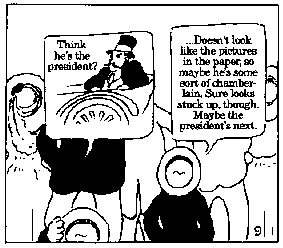 To this day, 40% of books produced in Japan are "comic books." Yet, they are not only to entertain and divert. They provide instruction on everything from history to sexuality, as well as political commentary and personal revelation. According to Schodt --- in his excellent introduction to The Four Immigrants Manga --- the Japanese learned the art of comic books not only from ancient line drawings of their own culture, but, as well, from the turn-of-the-century newspapers in America. Indeed, artists from the Orient travelled through the United States in the early part of this century to "study" the art of the comics.
To this day, 40% of books produced in Japan are "comic books." Yet, they are not only to entertain and divert. They provide instruction on everything from history to sexuality, as well as political commentary and personal revelation. According to Schodt --- in his excellent introduction to The Four Immigrants Manga --- the Japanese learned the art of comic books not only from ancient line drawings of their own culture, but, as well, from the turn-of-the-century newspapers in America. Indeed, artists from the Orient travelled through the United States in the early part of this century to "study" the art of the comics.
Schodt spent some time trying to trace the artist Henry Kiyama, who came to the United States in 1904 (he finally found him through the Library of Congress). Kiyama considered himself a member of the "student" class, and studied art at the San Francisco Art Institute, but came into his own with this comic book.
Schodt points out that it is a novelty: Kiyama created a 104 page book, what one might call a "graphic novel." He had it printed in Japan and brought back to San Francisco, and, once distributed here, it was highly praised in the expatriate press. For the editor (and the present reader) the book --- fully reproduced here --- provides wry insight into the hearts of Japanese, struggling with strange and often abrasive Americans. Indeed, a proud and well-educated Japanese student had to put up with boorish prejudice from people often far less educated than he was. And at the time of Kiyama's visits to the United States, James D. Phelan, mayor of San Francisco, was calling for their expulsion, and participated in what one writer was to call "an orgy of anti-Japanese legislation." Now for us literary nuts, this is a marzipan of excellent puns, metaphors, and allusions --- all contained on two pages. What makes it work is his breathtaking style. Hear this on Borges' blindness: Derrida then goes on to quote Borges on Milton, "He destroyed his sight writing pamphlets in support of the execution of the kind by Parliament. Milton said that he lost his sight voluntarily, defending freedom." There's a decided breathlessness in Derrida, a minefield (I almost wrote "mindfield") with enough visionary --- if you will pardon the expression --- insights to found a thousand PhD theses. It reminds me of the first time I picked up Bradley on Shakespeare, or David Reisman's The Lonely Crowd, or Marshall McLuhan's Understanding Media, or a current dynamite book on the perils of statism --- Seeing Like a State by the political scientist James C. Scott (a book, by-the-bye, that has been ignored by practically all of the au courant book review magazines). We read Bradley, McLuhan, Reisman, and Scott for the pleasure of great minds seeding and plucking great bouquets of insight. Derrida, too, is one of those people who reads and writes for the delight of connections, making his pages a veritable olla podrida of literature, jamming so many different thinkers into the same pot for our delectation that we come away from the table a little woozy from the richness of it all. Many of us have heard of Derrida but are afraid to enter the heady world of what they called "Deconstruction." Fear not. The Derrida Reader, is expertly edited by Julian Wolfreys (who has written three previous books on Derrida), and the fun is not only in the selections, but in Derrida's great pluckings, from literature and philosophy --- like this from Thus Spake Zarathustra: "And when I came out of my solitude and crossed over this bridge for the first time I did not trust my eyes and looked and looked again, and said at last, An ear! An ear as big as a man! I looked still more closely --- and indeed, underneath the ear something was moving, something pitifully small and wretched and slender. And, no doubt of it, the tremendous ear was attached to a small, thin stalk --- but this stalk was a human being! If one used a magnifying glass one could even recognize a tiny envious face; also, that a bloated little soul was dangling from the stalk. The people, however, told me that this great ear was not only a human being, but a great one, a genius. But I never believed the people when they spoke of great men; and I maintained my belief that it was an inverse cripple who had too little of everything and too much of one thing." When Zarathustra had spoken thus to the hunchback and to those whose mouthpiece and advocate [Mundstück and Fürsprecher] the hunchback was, he turned to his disciples in profound dismay and said: Verily, my friends, I walk among men as among the fragments and limbs of men [Bruchstücken und Gliedmassen]. This is what is terrible for my eyes, that I find man in ruins [zerstrümmert] and scattered [zerstreut] as over a battlefield or a butcher-field [Schlacht- und Schlachterfeld]. (Quoted from "On Redemption.")
Her explanation: when we were young, we were dutiful, trying the best way we knew how to please parents and teachers. In the process, we subsumed our normal child-self, much to our later sorrow (we were not allowed by them and by us to be children). They were much bigger than we were, they had all the power --- so we did the sensible thing: we became un-child in order to deflect the agony that came from living with a bunch of perfectionists (or alcoholics). After all, we didn't necessarily chose to be born in the household with all those potty people, but once there, we figured out that we were stuck, and we did what any sensible human would do in the same circumstances: we created a fake self in order to survive. Now comes Ms. Miller with a book that ostensibly fixes her attention in another direction --- fiction. She doesn't call it that, but we have here seven fairly lengthy narratives about the lives of seven fictional individuals or couples. We call this fiction --- ten characters in search of an author, as it were. In her tales, Ms. Miller has rounded up the usual suspects: inner isolation, physical and sexual abuse, marital unhappiness, the birth of a disabled child. Now, no matter how practiced her writing, we prefer to think that, like Freud, she's best as a historian --- and in the process of formulating historical ideas, she can be quite enlightening. Freud wisely eschewed writing novels --- and we are suggesting that Ms. Miller might consider the same. Her characters (Yolanda, Linda, Gloria, Daniel and Lilka) seem to come from the soap opera school of drama. Their thoughts border on the trivial, and the messages conveyed have the feeling of being rehashed from earlier writings. We suspect the author must have been aware of something missing when she pasted Paths of Life together, because she added, at the end, two "Reflections" --- one dealing with the problem with Gurus, the second entitled "What is Hatred?" It's in this penultimate section that, at last, her words come to life. For example: The rise of Hitler --- was it just the aberration of a powerful man conning an entire nation, or was there (or is there) something special about Germany that made it ripe for such peculiar brutality? In seeking an answer, she analyses the youth of Hitler (weak mother, abusive father --- a man who would regularly, and without cause, beat his son) and correlates that to the child-raising culture of pre-Nazi Germany. This culture, she contends, flowed from the tracts of Daniel Gottlieb Moritz Schreber, a doctor who invented the concept of Schrebergëten: She then reports the story of "the nannies of Leipzig." They were instructed to eat while they held children on their laps, but to never give food to the baby. However, To propose that Germany's statist brutality grew out of a cruel system of child-raising is breath-taking, but, for those of us who will never be able to conceive of the genesis of so much hate and violence in the culture that gave us Bach, Schubert, Mozart, Goethe, and Mann, it makes as much sense as any other theory we've run into.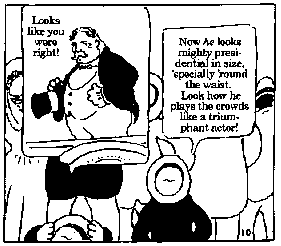 The Four Immigrants Manga may be crude in one sense --- as many of the "yellow journalism" comics were crude --- but it is rich with insight into what it must have been like for the Issei in a cold and uncaring culture.
Schodt has carefully examined the world of these hapless visitors, and offers extensive explanation for the more obscure panels. He points out, for example, that the balloons were a mix of English and Japanese characters.
The Four Immigrants Manga may be crude in one sense --- as many of the "yellow journalism" comics were crude --- but it is rich with insight into what it must have been like for the Issei in a cold and uncaring culture.
Schodt has carefully examined the world of these hapless visitors, and offers extensive explanation for the more obscure panels. He points out, for example, that the balloons were a mix of English and Japanese characters. It may seem odd to have the Americans speaking in broken English and the Japanese speaking fluently, but there is an intended logic here...in Hollywood movies, foreigners often speak in a crude pidgin English while the Americans speak perfectly. Yet in the world of immigrants, the immigrants obviously speak their own native language fluently, and it is only when they try to speak unfamiliar English that their speech sounds odd.
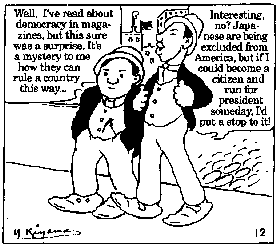 Of particular interest to those who are familiar with San Francisco will be the landmarks --- the Ferry Building, the Palace of the Legion of Honor, Seal Rock, and Golden Gate Park. One convention of American cartooning of the period that Kiyama does not adhere to is that of drawing obsequious Japanese with slanted eyes and buckteeth...On the contrary, he draws his Japanese characters with round eyes and a far more "Western" look than the Chinese --- a convention that survives to this day in modern Japanese comics.
Of particular interest to those who are familiar with San Francisco will be the landmarks --- the Ferry Building, the Palace of the Legion of Honor, Seal Rock, and Golden Gate Park. One convention of American cartooning of the period that Kiyama does not adhere to is that of drawing obsequious Japanese with slanted eyes and buckteeth...On the contrary, he draws his Japanese characters with round eyes and a far more "Western" look than the Chinese --- a convention that survives to this day in modern Japanese comics.
The
Derrida
Reader
Julian Wolfreys, Editor
(University of Nebraska)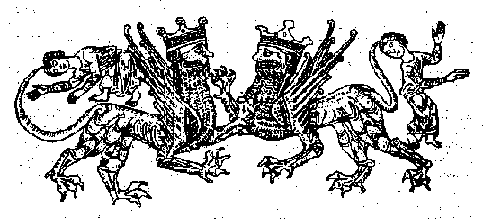 This Derrida is a regular Hoover vacuum cleaner. For instance, from The Memoirs of the Blind, he begins with an experience of temporary blindness that he had while in Paris --- an attack of frigore --- and moves on from that to a general meditation on vision (or the lack of it). As he sweeps us along, we suck up ideas like these:
This Derrida is a regular Hoover vacuum cleaner. For instance, from The Memoirs of the Blind, he begins with an experience of temporary blindness that he had while in Paris --- an attack of frigore --- and moves on from that to a general meditation on vision (or the lack of it). As he sweeps us along, we suck up ideas like these:For the wound is also a sign of being chosen, a sign that one must know how to recognize in oneself, the privilege of a destination, an assigned mission: in the night, but the night itself. To call upon the great tradition of blind writers, Borges thus turns round an invisible mirror. He sketches at once a celebration of memory and self-portrait. But he describes himself by pointing to the other blind man, to Milton, especially to the Milton who authored that other self-portrait, Samson Agonistes.
"...for there are human beings who lack everything, except one thing of which they have too much --- human beings who are nothing but a big eye or a big mouth or a big belly or anything at all that is big. Inverse cripples [umgekehrte Krüppel] I call them.
Life
Seven
Scenarios
Alice Miller
(Pantheon)
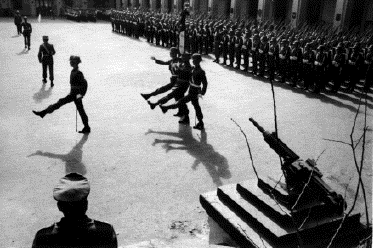 Alice Miller won the heart of all of us neurotics years ago with her book The Drama of the Gifted Child. She explained why angelic children like you and me turned strange, had break-downs, and generally became a mess when we grew up.
Alice Miller won the heart of all of us neurotics years ago with her book The Drama of the Gifted Child. She explained why angelic children like you and me turned strange, had break-downs, and generally became a mess when we grew up....here we are in the presence not of child-rearing methods but of systematic instruction in child persecution. One of Schreber's convictions is that when babies cry, they should be made to desist by the use of "physically perceptible admonitions...such a procedure is only necessary once, or at the most twice, and then one is master of the child for all time. From then on, one look, one single threatening gesture will suffice to subjugate the child." Above all [she continues] the newborn child should be drilled from the very first day to obey and to refrain from crying.
A nanny eating pears while holding one of his children on her lap was unable to resist the temptation of giving the infant a slice. She was immediately dismissed. The news of this draconian measure quickly spread to all the other nannies in Leipzig, and from that time on [there was no more] insubordination, neither with that child nor with any of the others that came later.